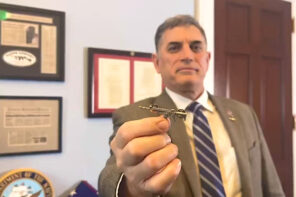Teenage boys love to take their dates to horror movies. There is no safer place to make a show of bravery. Don’t worry, Honey, I will protect you from the slasher, just cuddle up right here. What is truly delicious about horror movies is that everyone is safe. Characters rarely leap down off the screen and follow you home.
However, that does sometimes occur. In 1972 I took my then girlfriend, Ruthie, to a movie called Tales from the Crypt. The production was lent a shred of class by the appearance of some fine British actors, including Sir Ralph Richardson in the role of the old Crypt Keeper.
“Look! Ralph Richardson!” I recall saying, when she said she’d rather see Liza Minelli in Cabaret. “It’s practically Shakespeare!” Eventually she gave in.
Tales From the Crypt was based on the old EC horror comic of the same name that ceased publication in 1955, the victim of a real horror, the US Senate hearings on violent comic books as a cause of juvenile delinquency. Each issue of “Tales” was an anthology of three or four gruesome vignettes introduced by the creepy crypt keeper.
The movie retained the structure and the cheesiness of the original comic. The first vignette, “All Through the House,” takes place on Christmas Eve. A scheming woman, played convincingly by Joan Collins, murders her elderly husband in order to collect on his life insurance policy. After she buries his body in the cellar, an escapee from a local lunatic asylum, a knife-wielding psychopath dressed in a Santa suit, tries to break into her house. She runs around frantically locking doors and windows, only to discover that her innocent five-year-old daughter has invited Santa in, and is awaiting his “gift” with delight.
The movie had the desired effect; Ruthie was all over me. The problem was that evil Santa came home with us. Ruthie was scared to go to sleep. That night, and two or three times a week for months afterward, she woke with nightmares about the Santa Claus Man, as she came to call him. He became a regular feature of her dreamscape, chasing her down hospital corridors and across barren fields, breathing heavily and wielding his blade. In time his visits became less frequent and finally ceased altogether. She went into therapy and I became a little more wary about dragging people to movies they didn’t want to see.
Last week Santa came down off the screen again, this time in Covina, a town in Los Angeles, and this time the violence was real.
Here is the story, pieced together from a series of articles in the Los Angeles Times (see here and here).
Bruce Jeffrey Pardo was, according to neighbors, a mild-mannered, 45-year-old software engineer from Montrose, a suburb of Los Angeles. He was divorced and regularly attended mass. He worked for a defense contractor in Van Nuys, bringing home $122,000 a year. In 2004, a colleague at work introduced him to his sister, Sylvia Orza, a 39-year-old secretary “with a quick mind and an infectious laugh.”
She was also divorced. She had three children, the youngest of whom was a preschooler. They married on January 29, 2006. In February of 2008, Sylvia asked for a divorce, checking the box for “irreconcilable differences” when filing her papers. The marriage had “splintered” when Sylvia discovered that Pardo had a wheelchair-bound son whose existence he had never disclosed to her. “Pardo had abandoned his son years before, after the boy suffered brain damage in a near-drowning accident as the father baby-sat him… Compounding her anger was that Pardo continued to use the child as a tax write-off for seven years. She demanded he stop claiming his son as a dependent.”
The divorce became more contentious by the day. The house was in his name. She wanted to stay there until the end of the school year so her daughter could finish kindergarten in Glendale, and agreed to pay for utilities and groceries, and vacate the house on weekends during that time. He refused her offer. While she was attending a birthday party, he moved her furniture and belongings onto the driveway. Fortunately, Sylvia had a sister living nearby who could accommodate them. A judge ordered Pardo to pay her $3,166 a month in child support, but the next month he was fired from his job without severance. Other sources of income, he told the court, including a private consulting business, had also dried up. The divorce was finally settled on December 18. He kept the house and she received a single payment of $10,000 and the family dog.
At 11:30 pm on the night of Wednesday, December 25, 2008, Pardo arrived at the home of his in-laws dressed as Santa Claus and carrying a large, gift-wrapped package. A party with about 30 guests, many of them family, filled the cul-de-sac with seasonal music and cheerful voices. He shot the first person he saw, an eight-year-old girl who opened the door, then barged inside and began shooting at the guests, randomly at first but then more methodically, seeking out those he held grudges against. The wrapped package contained a device called the Fun Fueler, a five-gallon fuel can equipped with a hose and nozzle, powered by compressed CO2, and intended for use as a portable fueling system in remote locations. Pardo had filled it with high octane racing fuel which he sprayed on the furniture and walls, and ignited. Those who escaped ran to neighbors’ homes and called 911. A few minutes later the palm trees around the house shuddered from an explosion. Pardo, badly burned, the polyester suit fused to his flesh by the heat, got in his car and drove 40 miles to his brother’s house in Sylmar. Later that night he killed himself with a bullet to the head. He had an airline ticket for Iowa, where he planned to visit a friend, and $17,000 in cash strapped to his body.
So a crime that at first seems a rara avis reveals itself as the common gray sparrow of a disgruntled husband venting his rage on his wife and in-laws. What distinguishes it as “newsworthy,” beyond the scope of the tragedy and horror of the killings of innocent children and adults, are the theatrics: the Santa Claus suit, the Christmas Eve timing, the frightening Fun Fueler, almost a flame thrower, evoking the horrors of war.
In my recent book, Ceremonial Violence; A Psychological Explanation of School Shootings, I analyze 13 school rampage shootings, including the Columbine High School shooting, and describe how the offenders had in every case reached a point where they felt that they had no future and were ready to commit suicide, either literally, or socially, by killing others and being sentenced to a lifetime in prison. What distinguished them from other killers was their extreme and malignant narcissism; their enormous need for attention. They were, in common parlance, Drama Queens. J. L. Moreno, a psychiatrist who was a contemporary of Freud, had a particularly apt name for this. He called it “Act hunger,” the desire to go on stage—actually or metaphorically—and act out an inner conflict for all to see.
It is this need for attention that drives an individual who has nothing to lose to stage his violence as a ceremony: performing it in a public venue, in front of an audience, the larger the better; donning a costume that has symbolic meaning for him; choosing a significant date for the event (Columbine took place on April 20, Hitler’s birthday); and planning it with great care over a long period of time. Pardo planned out his shooting for at least six months. Through this ceremony, he hoped to add significance to his own crumbling life. In such a disturbed state of mind, it is easy to confuse significance with a few moments of fame or infamy.
Other recent adult rampage shootings have involved similar acts of ceremonial violence. On July 28, 2008, Jim Adkisson, an unemployed truck driver, entered the Tennessee Valley Unitarian Universalist Church during a youth group production of Annie and began shooting at attendees, killing two and wounding seven more. He claimed that Unitarian Universalism encouraged liberalism and liberals were ruining the country, but his real motivation was probably his hopelessness about the future, fed by a decade or more of failures: the failure of his marriage (his ex-wife was a member of the church where he had committed the shooting), his inability to find work, and the expiration of his food stamps.
School rampage shooters differ from their adult counterparts in several ways. While the former always tell friends about their plans, Pardo and Adkisson both kept their plans to themselves. Adolescents are often egged on to commit shootings by other teens who harbor the same resentment against teachers and peers but whose ego strengths restrain them from self-destruction; older rampage shooters need no outside encouragement. A third difference is that teens—at least those who live in rural communities—commit their shootings in schools, because the school is the center of the community. Pardo chose a Christmas party at his in-laws’ home because he knew that the people who mattered to him would be there.
Because Santa and Christmas are powerful symbols of generosity, kindness, and peace on Earth, Pardo’s transforming them into symbols of menace and betrayal, unpredictability and violence, became a simple and powerful way of generating fear.
Which brings us full circle, back to that writer for EC comics who may have created the idea of the evil Santa (or more likely borrowed it from some prior work of pulp fiction), and the film company that turned it into a movie that gave Ruthie nightmares many long years ago. To attract attention and create horror, to turn familiar symbols on their heads. Make children’s dolls evil, turn clowns into killers, have an innocent mother give birth to a baby who turns out to be the Antichrist. I am not suggesting that Pardo ever saw Tales From the Crypt or any of the other evil Santa movies (although he might have), or that his crime was somehow caused by one of these movies—I am suggesting only that artists and killers sometimes drink from the same well.
References
Fast, Jonathan. Ceremonial Violence: A Psychological Explanation of School Shootings. New York: The Overlook Press, 2008.
Kernberg, O F. “A Psychoanalytic Classification of Character Pathology.” Journal of the American Psychoanalytic Association 18, no. 4 (October 1970): 800-22.
Moreno, J. L. The Essential Moreno: Writings on Psychodrama, Group Method and Spontaneity. Springer Pub Co, 1987.




